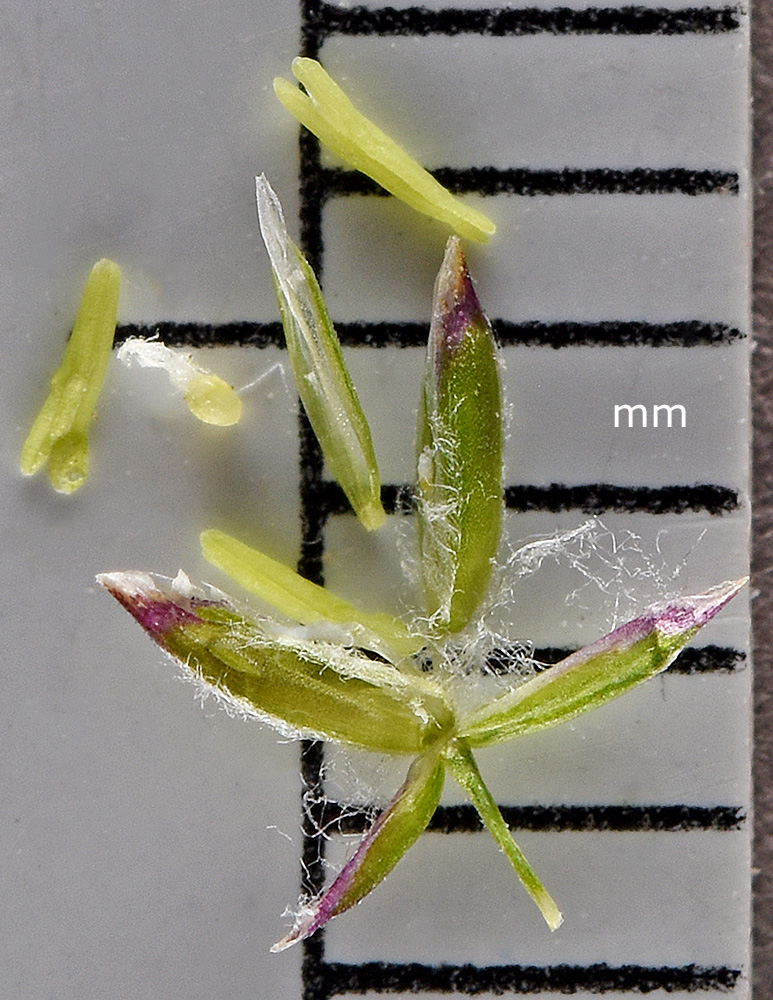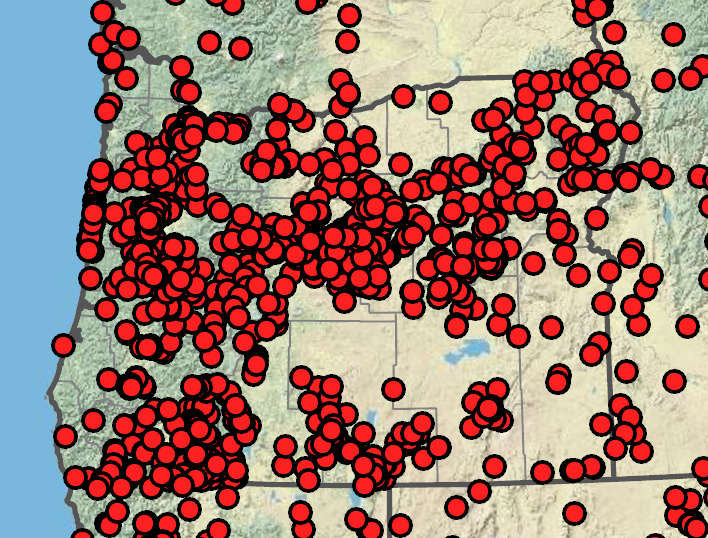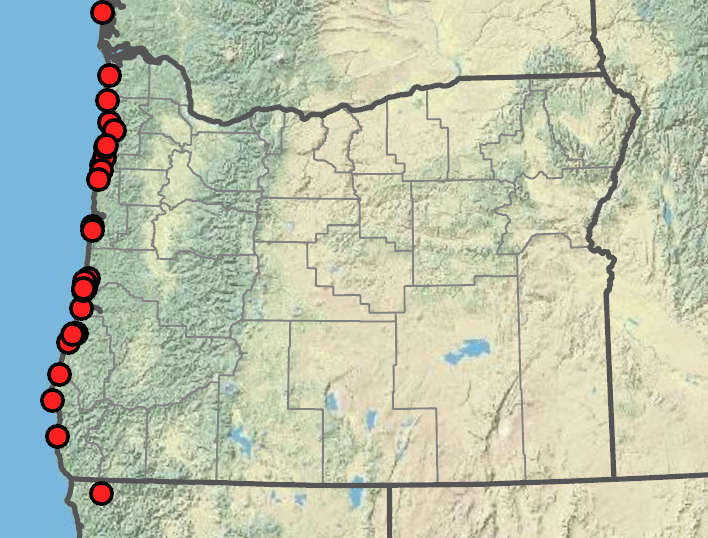Poa pratensis
Poa confinis
Kentucky bluegrass
coastline bluegrass
nodes terete or slightly compressed, 1–2(3) nodes exposed.
slender;
nodes terete, 0–1 exserted.
mainly extravaginal or equally extra- and intravaginal.
mainly intravaginal; some extravaginal.
sheaths closed 25–50% of their length, bases of basal sheaths glabrous;
collars smooth, glabrous;
ligules truncate to rounded, 0.9–2(3.1)mm, blades of extravaginal shoots like cauline blades, those of intravaginal shoots; when present, sometimes distinctly narrower; flat to involute, 0.4–1 mm wide;
cauline blades flat or folded; to involute on the margins, 0.4–4.5 mm wide;
lower surfaces smooth, glabrous;
upper surfaces smooth or sparsely scabrous, frequently with sparse; slender hairs 0.2–0.8 mm long; uppermost blades 1.5–10 cm.
sheaths closed 33–50% of their length; smooth, bases of basal sheaths glabrous;
collars smooth, glabrous;
ligules 0.5–1.5(2.2) mm, blades of tillers with upper surface moderately to densely scabrous or very short-hairy on and between the veins;
cauline blades involute, mostly filiform, 0.5–1(1.5)mm wide;
lower surfaces smooth;
upper surfaces sparsely scabrous on and between the veins; uppermost blade (0.5)1–5 cm long.
narrowly ovoid to narrowly or broadly pyramidal, loosely contacted to open, sparsely to moderately congested, 2–15(20)cm;
spikelets (25)30–100+;
branches spreading; (1)2–9 cm long; (1)2–7(9) per node;
spikelets 4–30(50), usually fairly crowded in distal half.
erect; ovoid, moderately to loosely congested, 1–5(7)cm;
spikelets fewer than 50;
branches erect to ascending, slightly lax, 0.5–3 cm, 1–2 per node.
to 3 times as long as wide; compact, 3–6(8)mm;
florets 2–5;
rachilla internodes glabrous or sparsely softly puberulent.
slightly unequal;
keels smooth or scabrous;
lower glumes 2–4 mm long, 1–3-veined; about 67% as long as the lowest lemma;
upper glumes 2.9– 5 mm long.
perennial; g ynodioecious, 7–30(35)cm tall, densely to loosely tufted, rhizomatous and stoloniferous;
rhizomes and stolons to 100 cm long.
with sparse; diffuse; cobwebby hairs 1–2 mm, infrequently glabrous.
lanceolate, 2.5– 4(4.5)mm, distinctly keeled, moderately to densely finely scabrous, glabrous throughout or keels and sometimes marginal veins proximally sparsely softly puberulent;
margins narrowly scarious;
tips acute.
vestigial and 0.1–0.2 mm or functional and 1.5–2 mm.
Poa pratensis
Poa confinis
6 subspecies; 5 subspecies treated in Flora.
Poa pratensis is a common grass with slightly nodding inflorescences and copious cobwebby callus hairs. Poa rhizomata, of rocky ultramafic slopes in southwestern Oregon, is similar but has sparse inflorescences, acute ligules, and unisexual inflorescences. Poa confinis of coastal sands has glabrous (to sparsely hairy) lemmas and diffuse, not tufted callus hairs. Poa wheeleri, a common eastern Oregon species, lacks the lemma hairs and has denser inflorescences and more strongly scabrous leaf sheaths. Poa pratensis is common, polyploid, and highly variable. It hybridizes with related taxa including P. alpina, P. secunda, and P. wheeleri. The resulting variation in P. pratensis can be perpetuated through both sexual and asexual seed production, resulting in many recognizable forms that are linked by intermediates. Most or all Poa pratensis found in Oregon are descended from three introduced subspecies (P. p. ssp. angustifolia, P. p. ssp. pratensis, and P. p. ssp. irrigata).
Coastal sand dunes and stabilized sandy soil, occasionally edges of coastal forests. 0–50m. Est. CA, WA; north to British Columbia. Native. 2n=42.
Poa confinis is a rhizomatous grass that often puts up shoots in clusters. It grows in coastal sandy habitats. Poa macrantha grows in the same habitat but has much larger lemmas and inflorescences. Poa pratensis has long hairs on the lemma keels and marginal veins and cobwebby callus hairs that arise as a tuft on the dorsal surface, sometimes also with two additional tufts by the marginal veins.
Rob Soreng, Barbara Wilson, Richard Brainerd, Nick Otting
Rob Soreng, Barbara Wilson, Richard Brainerd, Nick Otting
- Local floras:
BC,
OR,
WA
- Local Web sites:
Flora NW,
PNW Herbaria
WildflowerSearch
iNaturalist (observations)
USDA Plants Database
- LBJ Wildflower Center
- SEINet
- Plants of the World Online
- Encyclopedia of Life
- Wikipedia
- Google Image Search
- Local floras:
BC,
CA,
OR,
WA
- Local Web sites:
CalFlora,
CalPhotos,
Flora NW,
PNW Herbaria
WildflowerSearch
iNaturalist (observations)
USDA Plants Database
- LBJ Wildflower Center
- SEINet
- Plants of the World Online
- Encyclopedia of Life
- Wikipedia
- Google Image Search




